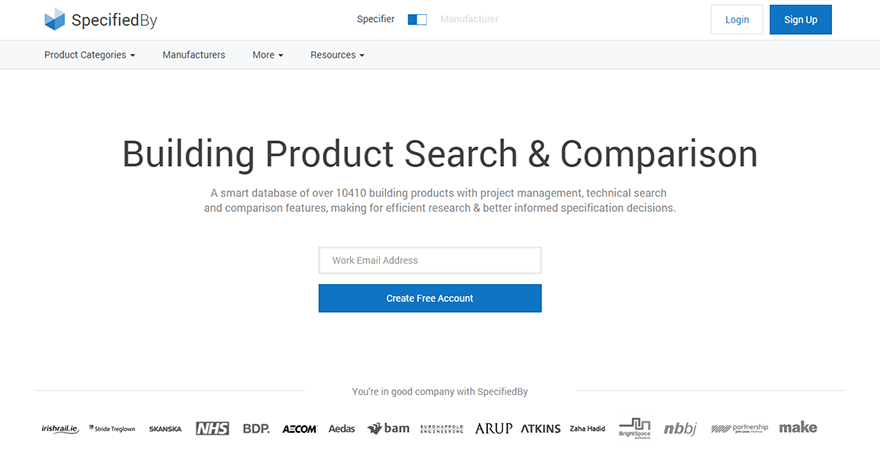Darren Lester, chief executive and founder of digital products database SpecifiedBy, on winning the BIM4SME Innovation Award, taking BIM beyond the 3D model and potentially tying in with the Digital Plan of Work.

Darren Lester
What is SpecifiedBy?
It’s essentially a database of around 10,000 building products featuring advanced filtering, search and comparison functions designed to help users make smart, informed and efficient specification decisions.
It is a more advanced version of existing product directories, like the RIBA Product Selector and Barbour Product Search – which although online have not really moved on from traditional printed directories – combined with the UK’s largest library of BIM objects, available to download.
We liken it to the Currys website where, if for example, you are buying a laptop, various filters can be applied to drill down from 200 products to the five or six that match your specific needs. It is also possible to compare products side by side, alongside standardised specifications, and check how they perform against each other.
Who is it for?
Specifiers, mostly architects and arch technologists, but also surveyors, contractors and facilities managers. It has different uses depending on the role in the supply chain.
The service is free to access, after registering, and includes a LinkedIn style messaging system enabling users to connect with manufacturers without giving them personal details. In addition, there is a project management function designed to help users manage product research and organise products into different folders.

SpecifiedBy is a database of 10,410 building products featuring advanced filtering, search and comparison functions
Congratulations on winning the BIM4SME Innovation Award, why do you think you won?
We didn’t expect to win because we are a web software company, whereas most of the nominations were practitioners using BIM on actual projects.
I like to think we showed what else can be done with all the digital data being generated by the industry. BIM is ultimately about digitising the construction industry, not just importing and exporting information from 3D models, we hope the award helps get that message gets out to other people. There is currently a danger that BIM will become a siloed thing, where it was originally envisioned to open up avenues to new ways working and collaboration.
Can advanced search and comparison help lay bare manufacturers product claims?
Yes, we’re trying to democratise this side of the industry and make it easy to highlight the best possible products to the specifier or designer, not the products that have had the most marketing money thrown at them.
Could this have a big impact on specification of more sustainable building products?
That’s something we were really interested in. There is so much “green wash”, but at the same time there are so many sustainable criteria you could judge a product on, which makes it hard to say one product is greener than another. We just want to bring some clarity to the debate and make all the data available, so the specifier can decide based on their own criteria which is the most sustainable product. It’s about having the information available to make an informed decision.
Where did you get the idea for the website?
It came to me while I was studying architectural technology at Edinburgh Napier University, and evolved while I was doing a Masters in Environmental Sustainability. After leaving Napier, the University of Edinburgh helped get the business off the ground, providing a £20,000 grant and free office space.
Is the plan to compete directly with NBS specification software?
There’s not currently anything on the market other than NBS’s software, which is in part because the industry sees their system as industry standard. SpecifiedBy is really positioned one step before NBS software, during the research phase, rather than when writing a specification document. At some point in the future we might be interested in getting involved that natural progression, either working with someone like NBS or doing our own thing.
Will you integrate with the Digital Plan of Work?
It’s something we are looking at, we have been in touch with the guys working on it. The NBS Toolkit has been developed in an open way using application program interfaces (APIs) to enable third party applications to integrate with it and access certain aspects of the data. If it does what most people hope, providing a foundation for people to build on and integrate with, it could trigger a series of new innovations.
You provide access to a library of BIM Objects, are enough manufacturers producing these now?
Not at all, the UK’s two leading content creators, Bimstore and the NBS National BIM Library, include objects from maybe 300 manufacturers, which combined with manufacturers who have made BIM object themselves is a small portion of the some 20,000 companies making products, materials and components.
This is partly down to a fear of the unknown and them not wanting to commit to something they are not 100% sure of. It’s also down to a lack of demand from clients on projects. It’s also true to say that some product types aren’t suitable for BIM Objects, although there’s a lack of clarity on which. Most manufacturers outsource their BIM Object content, but in future they will train people up and bring it in-house, in the same way they now do their own CAD drawings. This will enable them to customise objects on project by project basis rather have to offer standard objects off the shelf, as is currently the case.
How do you plan to expand the website in the future?
When working with huge datasets, you can start to make the software function more intelligently so it is able to suggest products based on what the user is looking at, or searching for. This could lead people towards more sustainable product choices. We’re currently looking at how this might work.















